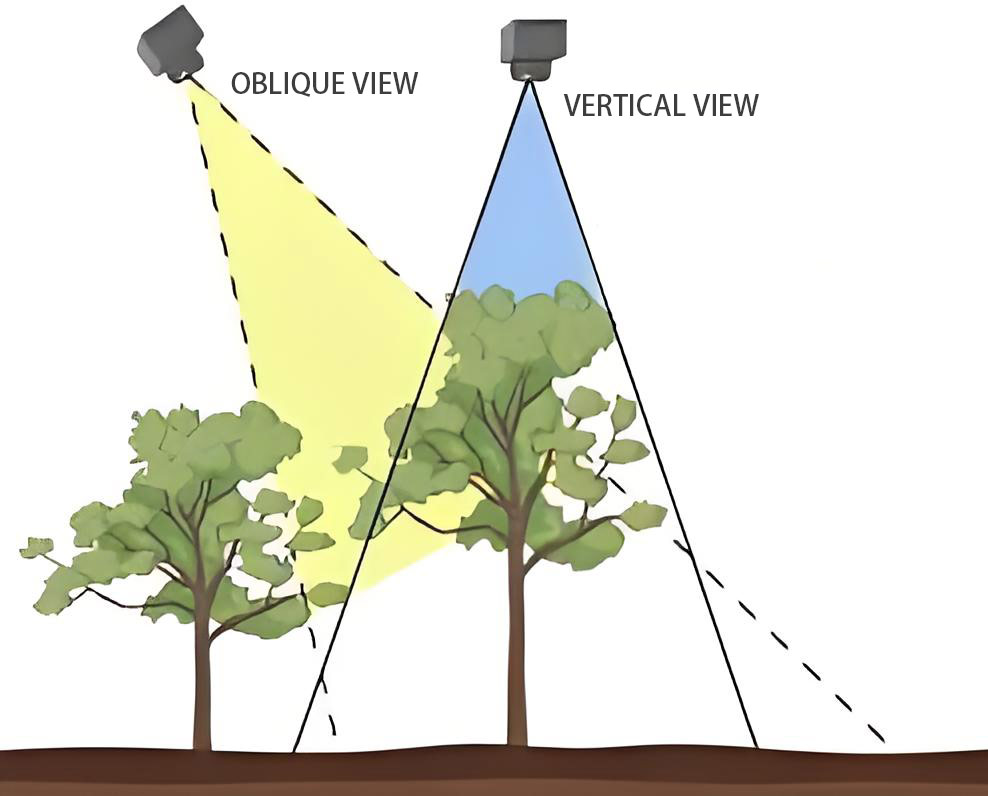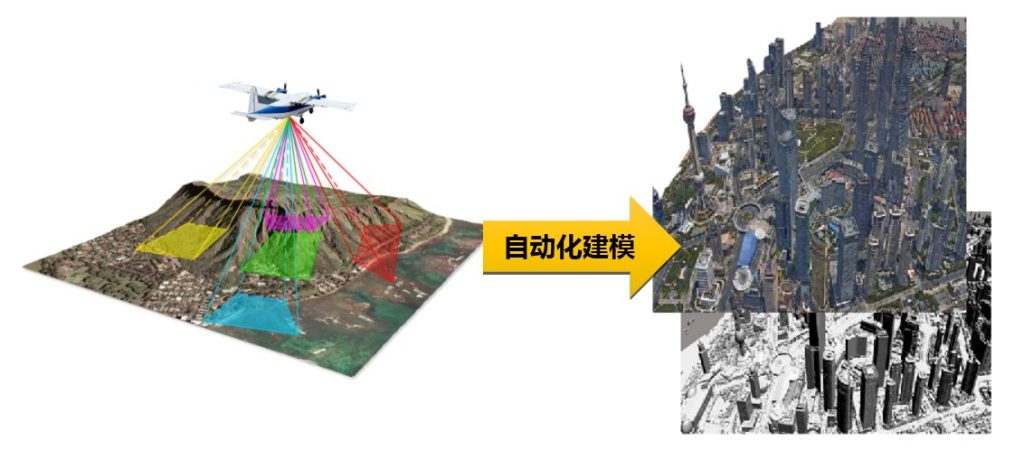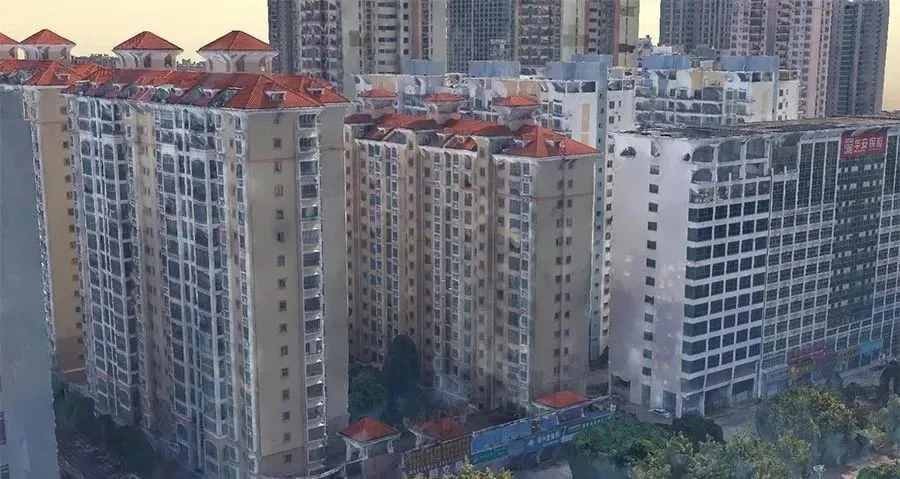In the previous two issues, we introduced two basic parameters of oblique cameras: focal length and field of view, as well as their relationship with modeling effects. The high-end Pros series oblique photography cameras can achieve better modeling results. So, what special designs do the Pros have in terms of lens arrangement and focal length settings? In this issue, we will continue to introduce the design logic behind the Pros' parameters.
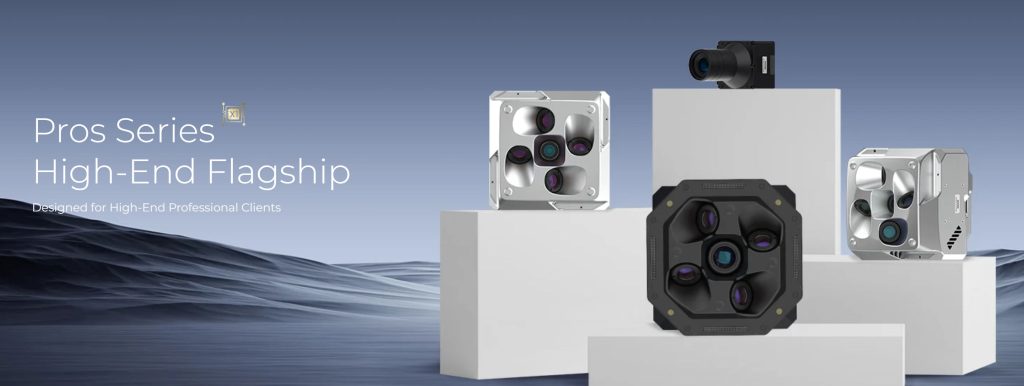 △Riebo pro series mapping camera
△Riebo pro series mapping camera
Lens Tilt Angle and Modeling Effects
In the last issue, we mentioned that the shorter the focal length, the larger the field of view, which allows for collecting richer facade information and thus better modeling effects. In addition to improving the focal length, we can also adopt another method to enhance modeling effects: directly increasing the tilt angle of the oblique lens, which can also collect more abundant facade information.
However, in actual production, although designing a larger tilt angle can indeed significantly improve the model effect, it has two serious side effects.
First, operational efficiency drops sharply. As the lens tilt angle increases, the number of expanded flight paths will increase significantly. When the lens tilt angle exceeds 45°, the flight efficiency drops sharply. For example, the professional aerial camera Leica RCD30 has an oblique lens tilt angle of only 30°, and one of the reasons for this design is consideration of operational efficiency.

Second, if the lens tilt angle is too large, oblique sunlight can easily enter the camera, causing glare (especially in the morning and afternoon on hazy days). Riebo cameras were among the first professional oblique photography cameras to adopt an internal alignment design, which is equivalent to adding a sunshade to the camera, preventing it from being affected by oblique sunlight.
Especially for small drones, their attitude is generally poor. When the camera tilt angle is superimposed with the drone's attitude, stray light can easily enter the camera, further exacerbating the glare problem.
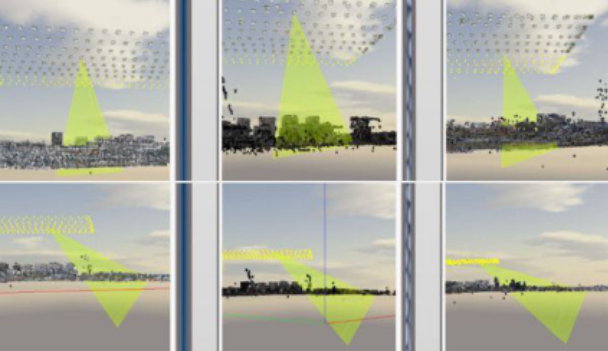
△Overlap Rate and Modeling Effects
From experience, in real-scene 3D modeling, to ensure the model effect, it is best that all five groups of lenses can cover the architectural features of any object in space during image collection.
This is easy to understand. For example, when modeling an ancient building, the effect of modeling through surrounding flight shooting is definitely better than taking only a few photos of its four sides.

The more images covering an object, the more spatial and texture information it contains, and the better the modeling effect. This is the significance of the overlap rate in oblique photography. The overlap rate is one of the key factors determining the model effect. In general scenarios of drone oblique photography, the overlap rate is mostly 80% in the forward direction and 70% in the side direction (actual data redundancy).
In fact, it would be best if the side overlap rate is as high as the forward overlap rate, but an excessively high side overlap rate will sharply reduce the efficiency of field flight operations (especially for fixed-wing drones). Therefore, considering operational efficiency, the side overlap rate is generally lower than the forward overlap rate.
Tips: Considering operational efficiency, a higher overlap rate is not always better. Beyond a certain "standard", increasing the overlap rate has limited improvement on the model effect. According to our experimental feedback, sometimes a higher overlap rate may even reduce the model effect. For example, in scenes with 3-5cm resolution models, the modeling effect after model thinning is sometimes slightly better than that with the original overlap rate.
Theoretical Overlap Rate vs. Actual Overlap Rate
In operations, the overlap rate we set (80% in the forward direction and 70% in the side direction) is only the theoretical overlap rate. During actual operations, drones are affected by air currents, and attitude changes will cause the actual overlap rate to be lower than the theoretical one.
Generally speaking, whether it is a multi-rotor or fixed-wing drone, the worse the attitude of the drone, the worse the modeling effect.
Because small multi-rotor or hand-thrown fixed-wing drones are lighter and smaller, they are easily disturbed by external air currents. Their flight attitude is generally not as good as that of medium/large multi-rotor drones, leading to insufficient actual overlap rate in local ground areas and ultimately affecting the model effect.
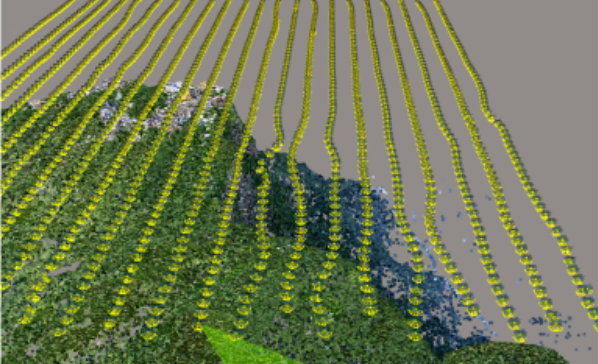
Tips: In early days, when drones were used for orthophoto surveying projects, due to low overlap rates, they were more susceptible to attitude influences. Therefore, after flight, in addition to checking the quality of aerial photos, it was also necessary to check whether the actual overlap rate of the aerial photos was close to the theoretical one.
Difficulties in Modeling High-Rise Buildings
Generally speaking, as the height of a building increases, the difficulty of modeling increases. First, high-rise buildings increase the risk of operational flights; second, as the building height increases, the overlap rate of the upper parts of high-rise buildings drops sharply, resulting in severe decorative cavities on the model roof.
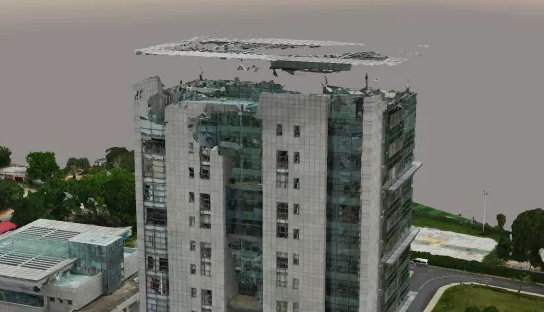
1. Impact of Increasing Overlap Rate on High-Rise Building Modeling
Many experienced customers have found a solution to the above problem: increasing the overlap rate. Indeed, as the overlap rate increases, the model effect improves significantly. The following is a comparison of our experiments:

△Forward 80%, side 70%

△Forward 85%, side 80%
From the above comparison, we can see that increasing the overlap rate has little impact on the modeling effect of low-rise buildings, but it greatly improves the effect of the top of high-rise building models.
However, as the overlap rate increases, for internal operations, the number of collected aerial photos increases sharply, data processing time extends, and problems such as aerial triangulation layering emerge. For field operations, flight efficiency is also very low, which is a trouble that customers who have done similar projects can deeply feel.
2. Impact of Improving Focal Length on High-Rise Building Modeling
In the article "Focal Length and 3D Modeling in Product Development", we learned that for urban facade building modeling scenarios, a longer lens focal length will lead to worse modeling effects. However, for high-rise building areas, a longer focal length is needed to ensure the model effect. As shown in the figure below:
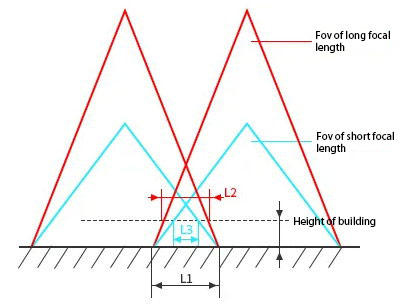
Under the same resolution and overlap rate, a long-focal-length lens can ensure the actual overlap rate of the roof and a sufficiently safe flight height, achieving better modeling effects for high-rise buildings.
For example, when the DG4pros oblique photography camera is used for modeling 100-meter-high buildings, it can not only achieve excellent modeling effects but also ensure the model accuracy meets the 1:500 cadastral requirements. This is the advantage of long-focal-length lenses. Case: Oblique Photography 1:500 Cadastral 100-Meter High-Rise Building Project Report.
PROS Series Camera
To achieve better modeling effects, under the premise of the same resolution, it is necessary to ensure sufficient overlap rate and the largest possible field of view. For survey areas with large terrain height differences or high-rise buildings, the lens focal length is also an important factor affecting the modeling effect. Based on the above principles, Riebo Pros series cameras have made the following three optimizations on the lens:
1. Improving Lens Layout
For the Pros series oblique photography cameras, the most intuitive feeling is that their shape has changed from the previous circular to square. The most direct reason for this change is the change in lens layout.
Currently, except for the Pros series, most drone oblique photography cameras adopt a surrounding layout, as shown in the figure below.
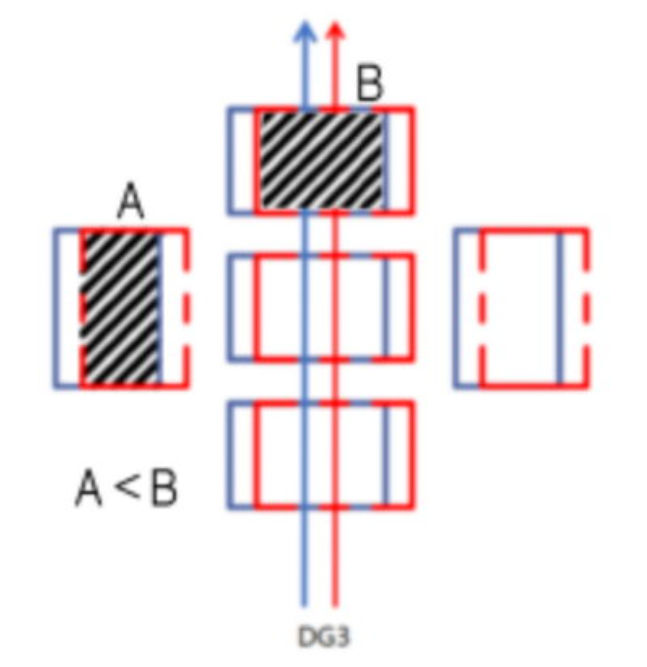
△Surrounding layout, representative camera: DG3
The advantage of this lens layout is that the camera can be designed to be smaller in size and relatively lighter in weight. However, this layout will cause the overlap rate of the left and right oblique lenses to be lower than that of the front, middle, and rear oblique lenses: that is, the area of shadow A is smaller than that of shadow B.
As we introduced earlier, to improve operational efficiency, the side overlap rate is generally lower than the forward overlap rate, and this surrounding layout will further reduce the side overlap rate. This is why the side model is more blurred than the forward model (you can check the existing model effects).
Therefore, in the RIY-Pros series, Riebo has changed the lens layout to a parallel layout, as shown in the figure below:
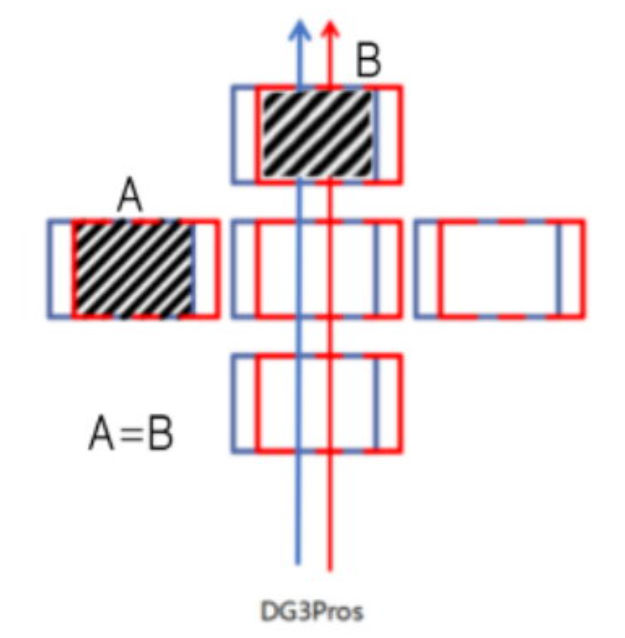
△Parallel layout, representative camera: DG3pros
This layout sacrifices part of the shape and weight but has the advantage of ensuring sufficient side overlap rate, achieving better side modeling effects. In actual flight operations, RIY-Pros can even reduce the side overlap rate a bit to improve operational efficiency.
2. Raising the Lens
The advantage of the parallel lens layout is that it not only ensures sufficient overlap rate but also increases the side field of view, enabling the collection of more texture information.
On this basis, we also increased the focal length of the oblique lens so that its bottom edge coincides with that of the previous traditional layout, further increasing the side field of view, as shown in the figure below:
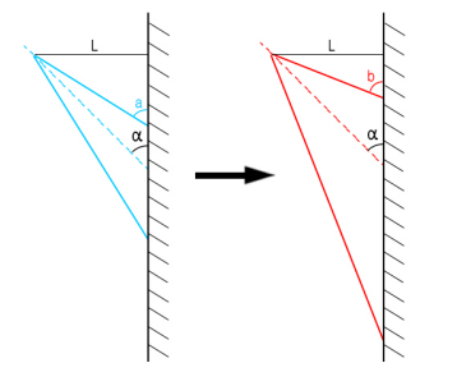
The advantage of this is that although the lens is raised, it does not affect flight efficiency. Moreover, after the field of view of the side-looking lens is significantly increased, more facade information data can be collected, and the modeling effect is naturally improved.

Comparative experiments also show that compared with lenses with traditional layouts, the lens layout of Pros can indeed better improve the problem of blurred eaves in the model in terms of side effects.
The left side below is the model built with materials collected by a camera with a traditional layout, and the right side is the model built with materials collected by a Pros camera.
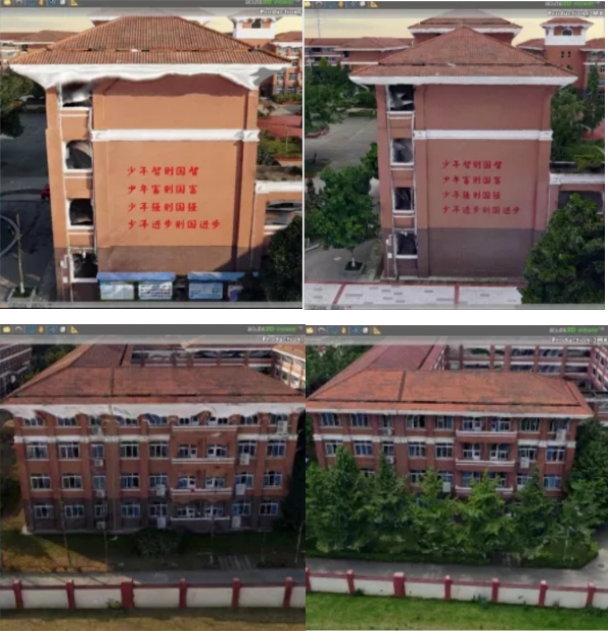
3. Increasing the Focal Length of Oblique Lenses
After changing the lens layout of the RIY-Pros oblique camera from the traditional surrounding layout to the parallel layout, the ratio of the near-point resolution to the far-point resolution of the oblique image will increase.
To ensure that the ratio does not exceed the critical value, the oblique focal length of Pros has increased by 5%~8% compared with the previous one. The reason for this design involves more professional knowledge in other aspects, and due to space limitations, we will not elaborate on it for the time being.
Postscript
Generally speaking, users only need to compare parameters and do not need to care too much about these underlying technical issues. The reason for writing these principle-based technical articles is, on the one hand, to provide references for some technically inclined customers and inspire more ideas; on the other hand, the design of various parameters actually involves many details and considerations. Introducing these underlying logics will also help customers gain a deeper understanding of the equipment and choose more suitable equipment according to their project needs.
As a pioneer in oblique photography technology, Riebo has been committed to developing more advanced equipment to better create value for customers!
